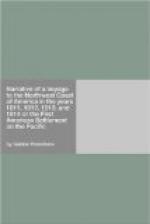As the French and English had both attempted to form establishments on these rocks, we endeavored to find some vestige of them; the tracks which we met everywhere made us hope to find goats also: but all our researches were vain: all that we discovered was an old fishing cabin, constructed of whale bone, and some seal-skin moccasins; for these rocks offer not a single tree to the view, and are frequented solely by the vessels which pursue the whale fishery in the southern seas. We found, however, two head-boards with inscriptions in English, marking the spot where two men had been interred: as the letters were nearly obliterated, we carved new ones on fresh pieces of board procured from the ship. This pious attention to two dead men nearly proved fatal to a greater number of the living; for all the casks having been filled and sent on board, the captain gave orders to re-embark, and without troubling himself to inquire if this order had been executed or not, caused the anchor to be weighed on the morning of the 11th, while I and some of my companions were engaged in erecting the inscriptions of which I have spoken, others were cutting grass for the hogs, and Messrs M’Dougall and D. Stuart had gone to the south side of the isle to look for game. The roaring of the sea against the rock-bound shore prevented them from hearing the gun, and they did not rejoin us till the vessel was already at sea. We then lost no time, but pushed off, being eight in number, with our little boat, only twenty feet keel. We rowed with all our might, but gained nothing upon the vessel. We were losing sight of the islands at last, and our case seemed desperate. While we paused, and were debating what course to pursue, as we had no compass, we observed the ship tacking and standing toward us. In fine after rowing for three hours and a half, in an excited state of feeling not easily described, we succeeded in regaining the vessel, and were taken on board at about three o’clock P.M.




